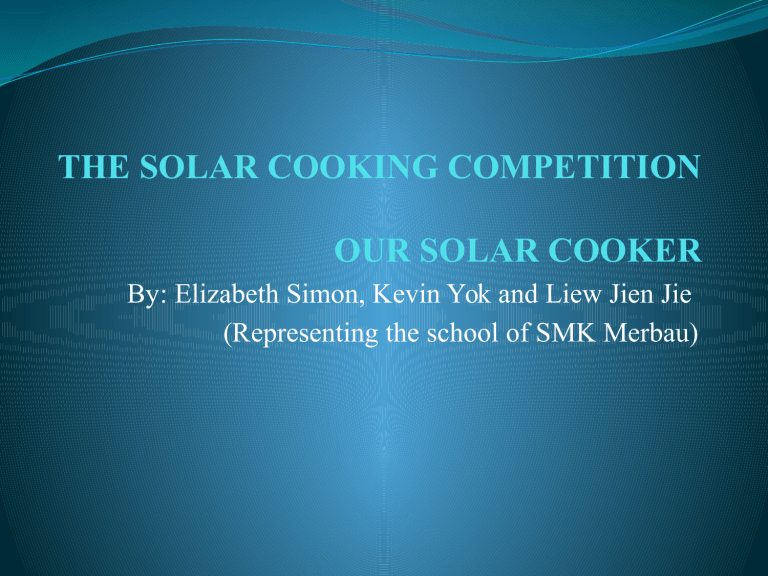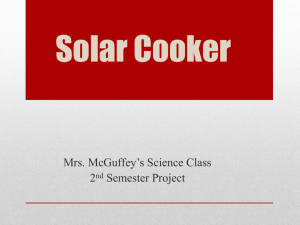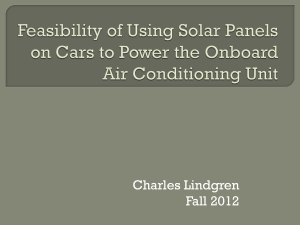
THE SOLAR COOKING COMPETITION OUR SOLAR COOKER By: Elizabeth Simon, Kevin Yok and Liew Jien Jie (Representing the school of SMK Merbau) Abstract Mankind will continue to use energy, even if we all make a concerted to cut down on our consumption. So another important step to take if we want to save the environment is to find alternative ways to produce and use sustainable, clean energy. The main purpose of our project is to replace old wood fuel stoves with an eco-friendly solar cooker that uses "green" energy. A solar cooker is a device which uses the energy of sunlight to heat food or drink or to sterilize it. Solar cooking is a form of outdoor cooking and is often used in situations where minimal fuel consumption is important, or the danger of accidental fires is high. The vast variety of the solar cookers presently in use are cheap, low tech devices because they use no fuel, no electricity required to operate, they reduce air pollution and slow deforestation and desertification. Objective / Aim To cook food in the process of using solar energy instead of electricity or fuel To find an alternative way to cook without using fuel. To conceive an innovative idea to save resources. Introduction and Problem Statements We would continue to waste earth's resources without proper management and efficiency. In order to solve this problem, we need an alternative way to overcome our needs for energy. This leads us to the use of green energy, a brilliant and effective way to overcome the problem. Advantages To conserve the usage of fuel. To save our cost by purchasing low cost of products instead of high cost of fuel. Prevent of air pollution. Prevent of global warming. There is no danger of burning food and flavours remain intact. Disadvantages Only functions during day time when weather is hot and sunny. Takes quite long to cook. Takes long time to build the solar cooker. Solar cookers are not as efficient at retaining heat as compared to conventional cooking devices. There is a risk of accidental injury or burns if the appliance is not used properly Materials Gravels D’ Arte black mat boards Foil paper Magnifying glass A4 Paper Plastic book wrapper Spray paint : Black Number 30 Poly foam Apparatus 500ml water container that absorbs heat Black binding tape Scissors PVA glue Board cutter Eraser Ruler Blue, black and red pens Pencil Big NT cutter blade Measuring cylinder Pictorial Descriptions and Steps Steps and Description 1. 2. Prepare the materials and apparatus. Cut 5 mat boards for each size according to sizes 30.5 cm x 30.5 cm and 38 cm x 38 cm with a board cutter. Pictures Steps and Description Pictures 3. Line the inside of the small box and large box with foil paper using polystyrene glue. 4. Join the cut 30.5 cm x 30.5 cm and 38 cm x 38 cm mat boards to make a box by taping the sides using a binding tape. 5. Cut up some poly foam with scissors and stuff them into the space between the side walls of the small box and large box. (Currently not available) (Currently not available) Steps and Description 6. Prepare another 4 mat boards and cut them according to the size shown with scissors. 7. Fold all the flaps according to the dotted lines. 8. Line the inner surface of the collectors exclude all the flaps with foil paper. 9. Join the side flaps of all mat boards with binding tape. Pictures Steps and Description Pictures 10. Tape the bottom flaps to the 11. 12. 13. 14. 15. inner part of the small box with binding tape. Spray the water container with black spray paint. Measure 500 ml of water with a measuring cylinder. Pour the water into the water container. Put some gravels and the water container into the plastic book wrapper. Put a magnifying glass on top of the wrapped water container. (Currently not available) (Currently not available) Steps and Description Pictures (Currently not available) 16. Wrap the whole solar cooker with another bigger plastic book wrapper. 17. Measure the initial temperature. 18. After several hours, measure the final temperature. (Currently not available) Scientific Theory - Accumulation of Heat Foil paper helps to reflect the sunlight. Magnifying glass helps to enhance the amount of sunlight and heat. Gravels can absorb and retain heat. A plastic book wrapper can trap the heat. The poly foam helps to insulate the heat so that it prevents heat loss. A dark water container used can get very hot in sunlight compared to light surfaces. Scientific Concept Application Reflection - Aluminium foil helps to reflect the sunlight to the water container. Greenhouse effect - The plastic book wrapper creates green house effect by trapping the heat that enters the solar cooker. Refraction – Sunlight is focused directly to the side of the water container. When sunlight travel through a denser magnifying glass medium light gets refracted and is focused more towards the normal. Reasons of Colour Chosen Opposed to white, which is.. Black is… • • • • Dark Dull Good heat absorber Good heat conductor • • • • Bright Shiny Poor heat absorber Poor heat conductor Trial and Error Monday Thursday Initial temperature : 30°C Initial temperature : 30°C Temperature after 2 hour s: 50°C Temperature after 1 hour : 50.5°C Solar energy absorption: The result seems to be better on Thursday compared to Monday as they are some changes made to the solar cooker. Example: a) More gravels are put to absorb and remain the heat. b) The gravels had been spray to a darker colour. c) A large plastic book wrapper is used to trap the heat. Conclusion Solar cooker helps to conserve fuel. Solar cooker requires less cost compared to the cost of fuel. Mankind should use solar cooker in order to conserve fuel for the sake of the next generation. END OF PRESENTATION Now for question and answer session. (Q & A Session) THANK YOU FOR YOUR ATTENTION

